Film Review: 120-Format Kodak Ektar 100
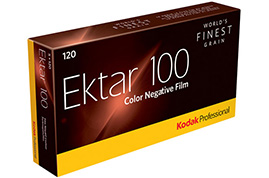
I managed to get my hands on some 120-format Kodak Ektar 100 before it was available to the general public, and I was given the opportunity to conduct an informal review of the film. Based on the hype surrounding this film, I was quite happy to test it out. After shooting 5 rolls through a few different cameras, I was not at all disappointed with the results as I scanned them in.
I found the colors to be extremely natural and pleasing under daylight conditions. And the sharpness and grain are absolutely to die for. In general, the film has the best characteristics from both slide film and color negative film. Read on for my informal review.
ABOUT THE FILM
Kodak Professional Ektar 100 is a color-negative film (using the C-41 process) available in 35mm and 120-formats. It is claimed to have extremely fine grain (the world's finest for color-neg) and high color saturation, making it ideal for nature, landscape, and travel photographers.
In September, 2008 the Ektar 100 became available in 35mm format. Due to popular demand, Kodak has made the film available in 120-format in April, 2009 (I believe it's available for purchase through a few vendors right now).
MY NON-TECHNICAL REVIEW
Equipped with a pro-pack of the Ektar 100, I loaded up my two medium format cameras and headed out on a few photowalks along the coast. One camera was my old 1956 Minolta Autocord MXS (twin lens reflex) and the other was my Diana+ (toy camera). I must admit, putting this film into a plastic toy camera felt a bit like ripping the engine from an F-1 car and strapping it to a tricycle.
The first day I shot this film, the weather turned heavy overcast quite rapidly, but I managed to finish off three rolls. I went out a few days later and shot the last two rolls in full sunshine. The film can certainly be used in either condition, but its white balance is intended for daylight use. The overcast photos just scanned in a bit cold — and I could have adjusted it, but it seemed fitting to leave them as is.
Up to this point, I've been shooting mostly Kodak Portra VC color-neg films on medium format (and a little bit of Velvia slide). The Ektar 100 seems quite comparable to the color saturation of these films, but the colors on the Ektar 100 seem more “realistic” to me. The color saturation and contrast isn't so overbearing that it looks unnatural, and the colors seems to closely represent the actual colors of the scene. One thing I did notice, though, is that the greens tend to be more saturated than the other colors — sometimes a bit too much.
The shots (especially those from the TLR) appear to be very sharp and free from grain. I might even go so far as to say that the Ektar 100 is comparable to Ilford's PanF Plus black and white film (which is the primary film I use with my Autocord). Though I've only scanned the film (which tends to present softer grain versus an optical enlarger), I was hard-pressed to find any signs of grain even at 100% zoom on a 3200 ppi scan.
GRAIN? WHAT GRAIN?
If you don't believe me, see for yourself. Here's an image with a decent exposure — the little box is the spot I've taken the 100% crop for the image immediately below it. The full image is approximately 50MP, or 7000 x 7000 pixels.
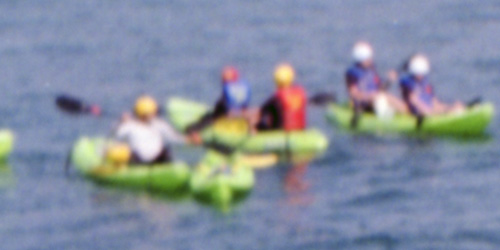
The softness of the 100% crop probably comes from scanning the film since I don't use any sharpening while scanning. Even so, I can usually make out the grain easily on most films — it's just not as sharp as with an optical enlargement. The Ektar 100 scans don't show much sign of grain.
MY FINAL THOUGHTS
I like it — a lot. When I decide to shoot color on my TLR, I'll probably use the Ektar 100 exclusively. The colors look great and the shots appear to be very sharp and fine-grained. I'm still undecided with the Diana+… I might try a few more rolls and see how it goes, but I'm still leaning toward the Portra VC films just because I have a history of good results with it.
The Ektar 100 film seems to have similar features of slide film (high saturation and fine grain), but with a more forgiving dynamic range of a color negative.
But the thing that gets me most about this film is how natural the colors appear. Color film often has a “film-like” appearance to it because of shifted colors or grain. The Ektar 100 (to me) looks more like a well-processed digital than it does a typical film.
Would I recommend this film for color enthusiasts? Certainly! It seems well-suited for landscape and nature photography, but even skin tones in portraits aren't completely unnatural.
SWEEPSTAKES OFFER
As a promo for the new Ektar 100 films, Kodak is running a bit of a sweepstakes giveaway along with a rebate offer on the film. You can get a $5 mail-in rebate for certain film purchases, and that rebate automatically enters you into a drawing for a prize package. The prize is a nature photography experience at Disney's Animal Kingdon Park, including a 4-night stay and a full itinerary of activities. You can also enter the prize drawing without buying the film or mailing in the rebate. Visit the official sweepstakes web page for more information.
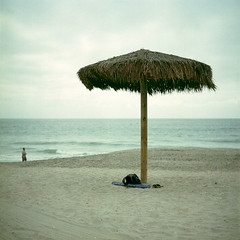
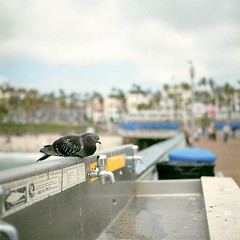
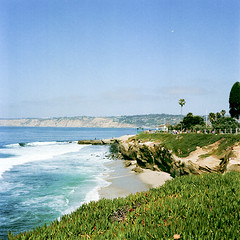
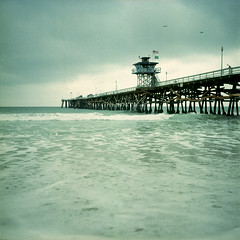
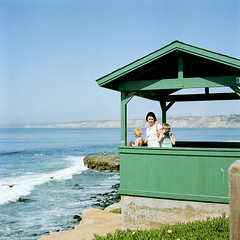


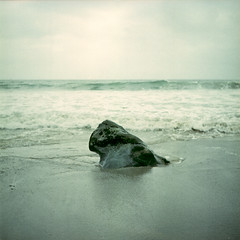
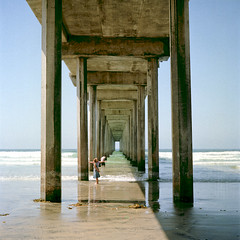
Ed Z
April 6, 2009Thanks for the writeup Brian! When it comes to film, I’m pretty much exclusively B/W – but this stuff had me curious 🙂
Michael W. Gray
April 6, 2009Good to know the film performs well in the 120 format. I just got in some of the 135 format to try out and look forward to putting it to use. Considering the quality you got out of the 120 format, it looks good for the lesser 135. Thanks for the review, at least I can look forward to a quality negative film when I get my Mamiya 645 some day.
Michael
Andrew
April 6, 2009Hi Brian,
What kind of scanner are you using for your 120 negs? I’m thinking of getting the Epson v500 and could use some advice. thanks!
Udi Tirosh
April 6, 2009AH! just like the good old days! film reviews.
nice to see they are still making new ones. Thanks for this, Brian.
Janne
April 6, 2009I’m going to pick up a few rolls once I see it in store. But your review has me just a little apprehensive; if it delivers the same kind of color-accurate, neutral grain-free results you can get from digital – well, I have a good digital camera already. Of course, the whole process of shooting MF film is completely different (and more enjoyable to me) so it may well be that it combines the best of both worlds for some situations.
Brian Auer
April 6, 2009@Janne Good point about the similarity to digital… but it still has a bit of a “film” look to it. As you can also see, the appearance is quite different under cloudy conditions. It might be a good film for such conditions if you’re looking for something different. You’ll have to give it a shot — I’m curious to hear what you think of it.
@Andrew I’m using a CanoScan 8400F, which is the older version of the 8800F (which I’m saving up for). The V500 looks very similar in capability, but I don’t have any direct experience with it.
Atniz
April 7, 2009It looks very clear and sharp. I am using Epson 3 in 1 scanner. I doubt I can get the quality like this from my scanner.
iheartfilm
April 19, 2009It’s funny what some people will pay for an old roll of Ektar 25 on ebay ($30 last time I checked). Why’s that funny? Because apparently Ektar 100 is pretty much the same thing. I know, I know, there’s the nostalgia/novelty factor, but Ektar 100 is a sweet film. No reason we shouldn’t use it.
tuco
April 27, 2009You’re looking for sharp, rich color on a new film with an 1955ish lens in that Autocord? Um, okay. I think you should have used a modern lens as well.
Brian Auer
April 27, 2009That’s the best I’ve got and Kodak knew that before sending me the film. The Autocord is sharp, and the colors seem to come out fairly well. I think the main loss in sharpness and color saturation would have come from the scanner as opposed to the camera. My b/w prints from this camera are noticeably sharper than the scans.
Huh Ima idiot
May 6, 2009what the hell do you mean the sharpness is due to optical scanning? idiot – your image is not sharp because your shooting at f13 and not f32 on a diana.
what the hell does “Color film often has a “film-like” appearance to it because of shifted colors or grain?” mean? what the hell is a shifted grain? bad scans make bad images, thats all. Your review is horrible and in no way demonstrates what this film is capable of
Brian Auer
May 6, 2009What I mean is that I’m not using an expensive drum scanner and I’ve seen that the scans coming from my particular hardware are far softer than optical enlargements achievable in my darkroom. And I wasn’t commenting on the sharpness of the images coming from the Diana — I realize that a plastic toy camera won’t produce sharp photos — I’m not stupid. The image shown above at 100% zoom actually came from my TLR shot at f/8 — around 2 stops from wide open.
And I never said anything about “shifted grain” — that statement should read as (shifted colors) or (grain), not (shifted)(colors or grain).
John
May 31, 2009Very helpful nonetheless. And it does say a non technical review so not sure why the few hard comments. The overcast photos have a great quality in tone, mood and composition. It’s nice to see pleasant photos of real things and not brick walls and other crap digital inspires other “test experts” to perform. I ordered a few rolls to try out on a Fuji GW690III. Thanks.
Brian Auer
May 31, 2009Great to hear you got some use of my review! Let us know what you think of the film after you shoot a few rolls.
Rob Oresteen
June 16, 2009Nice review on the Ektar 100. I’m shooting some in my Nikon N55 and a friend’s Rollie TLR.
I’m hoping it will be a decent film for skin tones.
Thanks,
Rob
jeremy
June 20, 2009thanks for the review. It looks to be a superb film.
I’d love to use it, however I just can’t find anyone selling it here in Britain.
Adirec Torytski
July 27, 2009You certainly did a thorough job with your research. I would say that the daytime shots, some of them at least, were very impressive and the comments regarding the grain is very impressive and really make a person consider a change.
Thanks a lot for the information and I will consider using Ektar 100 in the future based on your results.
Regards
Adirec